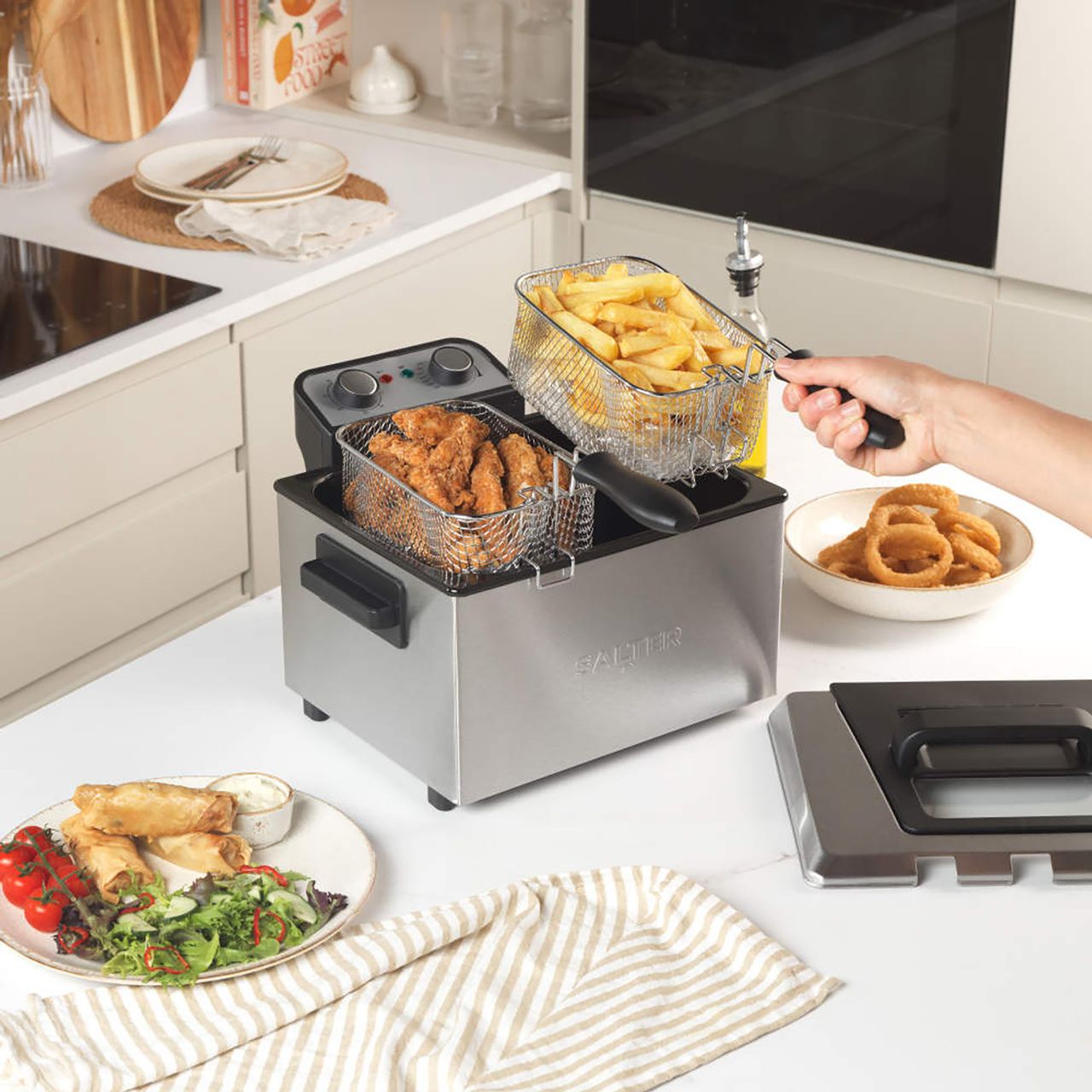
I'll be totally honest now: I've never used one of the best deep fat fryers. Yes, I grew up having one in my kitchen, and I distinctly remember my Mum fretting about us going anywhere near it (and now I get it!), but I've never actually used one to cook. I mean, I've tasted the chips — and I often dream about them. But, as soon as I was old enough to move out and started investing in my own kitchen appliances, the best air fryer came along and, well, we all know how that went...
Anyway, I've finally gotten my hands on a deep fat fryer, and I've been using it in my kitchen ever since, to cook everything from halloumi to potato rostis and even onion rings.
This Salter Deep Fat Fryer (£60 at Salter) makes this cooking process incredibly easy, and the results make it so tempting to give this appliance a permanent spot on our kitchen countertop. However, while I did love it, I can't deny that these appliances aren't the safest to use while our toddler is around.
For less than £60, though, this deep fat fryer is a great choice for families, and its 5L of cooking space makes it perfect for use while hosting, too. Here's what else I thought, and the results of my cooking. I hope you're not hungry...
In a nutshell
As deep fat fryers go, this one is simple to use and easy to clean, plus it offers 5L of cooking space over one basket (if you're cooking one type of food), or two 2.5L baskets for when you're cooking different things simultaneously. These baskets are sturdy, but they do have removable handles for storage purposes. There are two dials, one for the timer and the other for the temperature, as well as two lights — one red, one green. This deep fat fryer heated up fast, reaching 130°C in just 6 minutes. It can reach 190°C at its highest.
Design-wise, it's handy that the heating element and display table with the dials can be removed from the deep fryer basket to allow for easy cleaning. The exterior is metal, so this gets greasy fast. The one thing I disliked about this deep fat fryer is that its cord isn't very long — at 3ft. This meant I was pushed into a corner (literally) when it came to where I could use it on my kitchen worktop.
In terms of value for money, I think it's well worth it as its large size means it could easily feed a family of four or five.
Product Specs
- Type: Deep fat fryer
- Dimensions: H34.4cm x W35.9cm x D23.8cm
- Cooking area: D23cm x W29cm
- Weight: 5.8kg
- Temperature: 130–190°C
- Power: 3000W
- Size: 5L (or 2, 2.5L baskets)
- Colour: Silver
- Material: Metal housing, plastic display panel and dials, steel baskets, plastic handles
Unboxing
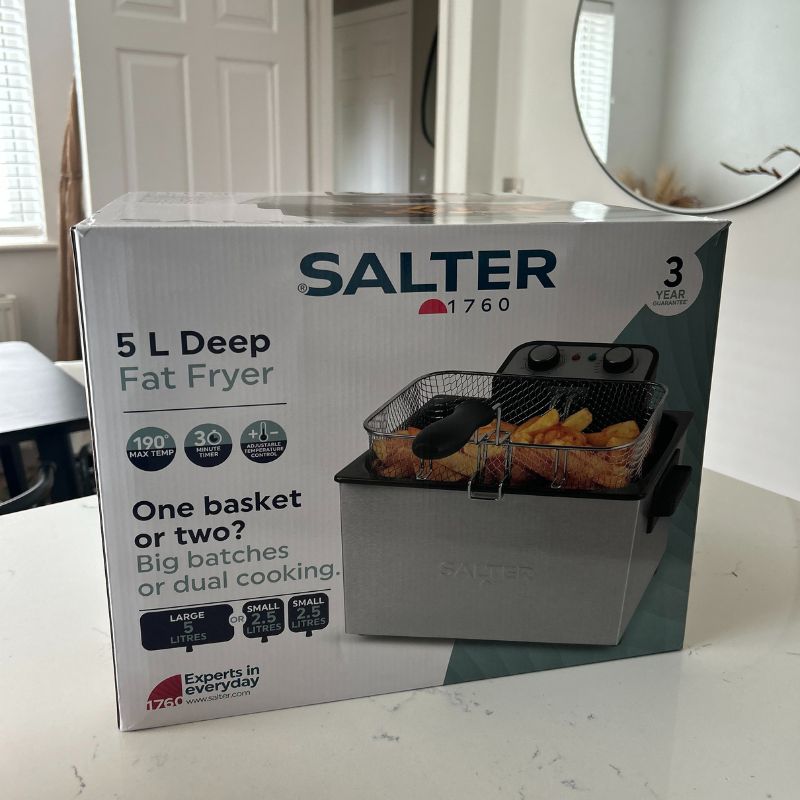
It arrived in a large box that was light enough for me to carry and lift onto my kitchen worktop. Inside this box was the actual deep fat fryer box, which had lots of information about the deep fat fryer printed on it.
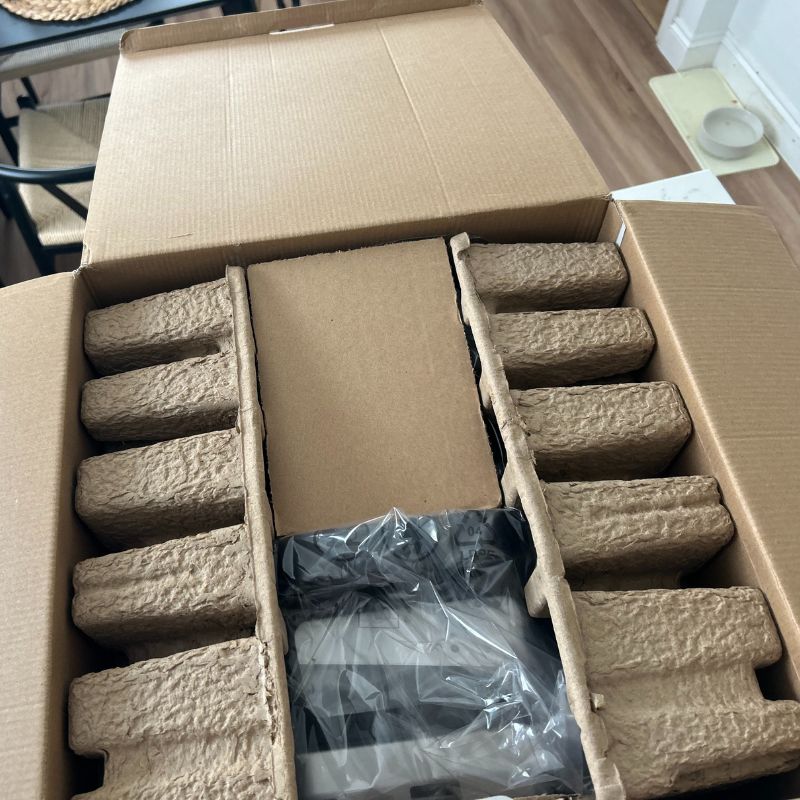
At first glance, I was impressed that lots of the packaging seemed to be cardboard, but when I finally managed to pull the main unit out, I realised everything else was wrapped in plastic bags. The main unit sat in a large bag, while every basket and each handle had its own bag, too. This was, admittedly, excessive.
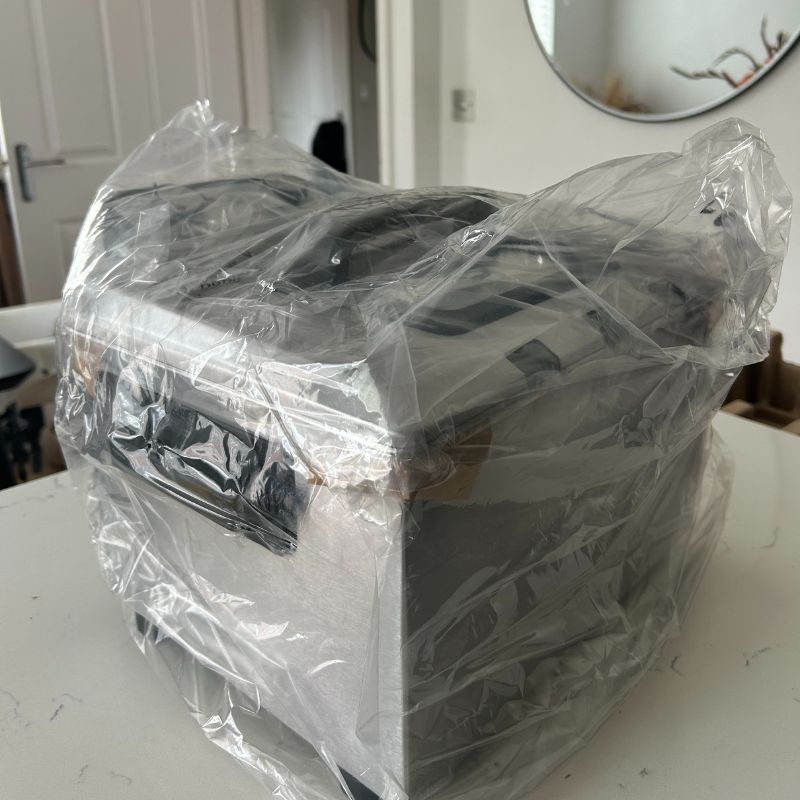
First of all, I read through the instruction manual and spotted that it recommended to clean all baskets and handles before first use. It also said to wipe the interior of the fryer with a damp cloth and dry it.
I unboxed a piece of paper with a warning, which explains how to attach the handles to the basket. There's a video, too, which I would definitely recommend watching as I eyeballed it first of all, and it turns out the handles were on wrong — if they feel wobbly, then you've done it wrong.
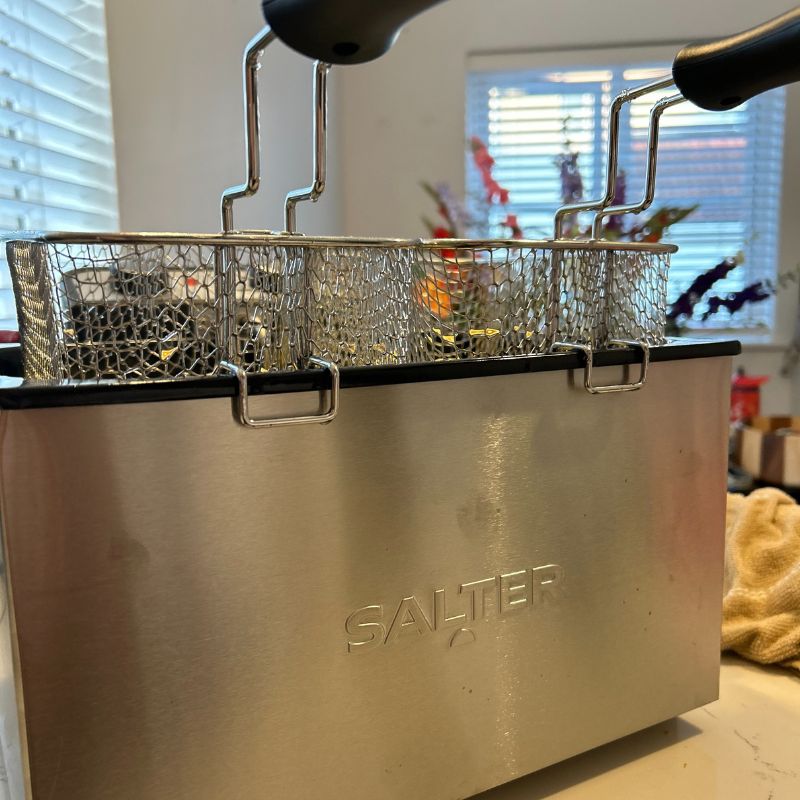
Cooking
As I've already mentioned, this deep fat fryer is extremely easy to use — but you do need to use it with caution. It's important that it's placed on a stable surface, with a lot of room around it to ensure it doesn't tip while in use. I also recommend placing it somewhere that's completely out of the way of children, and definitely make sure that they can't reach the basket handles.
On the display, there are two dials, one for the timer and the other for the temperature. The timer dial is the one on the left, and this corresponds with the red light. This light will turn on when the timer is activated. You cannot turn the timer off, which I presume is a safety feature. Once the timer is off, the deep fat fryer will switch off and begin to cool down.
The dial on the right is for temperature, which starts at 130°C and reaches 190°C. The green light corresponds to the temperature — it stays on until it reaches the desired temperature, then it will switch off to tell you it's ready for frying. This light will cycle between on and off, which is its way of telling you that it's maintaining the heat you've selected.
After filling it with oil to the minimum fill line, which is roughly 4.3L, the first thing I thought I would test was how long it took to heat. I started my timer and set the fryer to 130°C. It took roughly 6 minutes 30 seconds to reach this temperature. From here, it took 3 minutes to hit the hottest temperature, which is 190°C.
Cooking chips
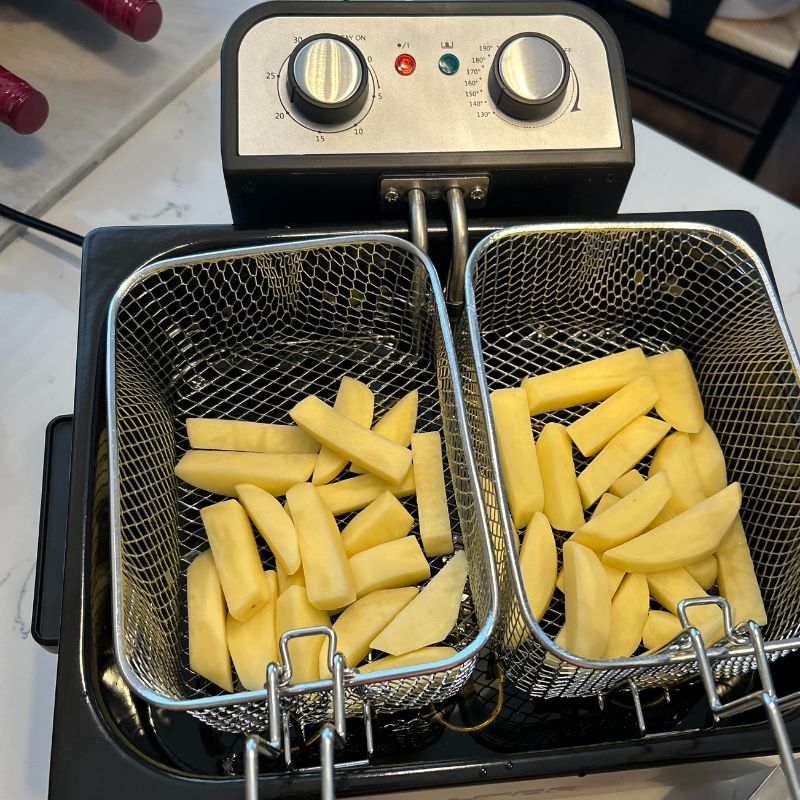
Before cooking our chips, we cut the potatoes and dried them as much as we could. We found a recipe online that said to initially cook them at 130°C, for 10 minutes. Then, take them out, let them dry and shake some oil off them. After, pop them back in on a higher heat, at 190°C, for 4-5 minutes.
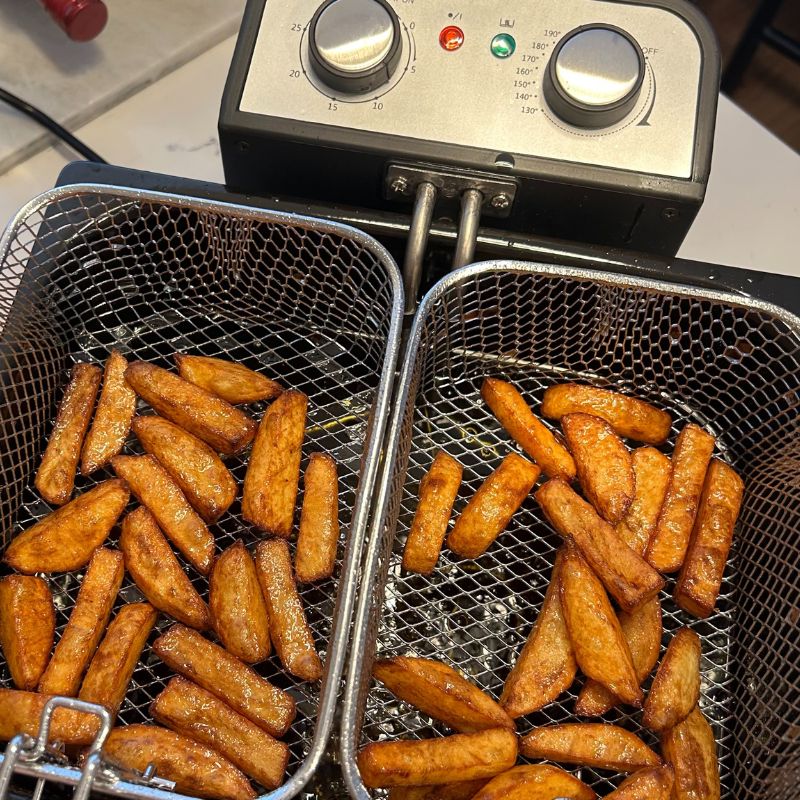
We did this twice, and the first time we did the second stage for 4 minutes and the second time we did it for 5. They tasted incredible both times, but leaving them in for that extra minute gave them that extra crunch.
Cooking mozzarella dippers
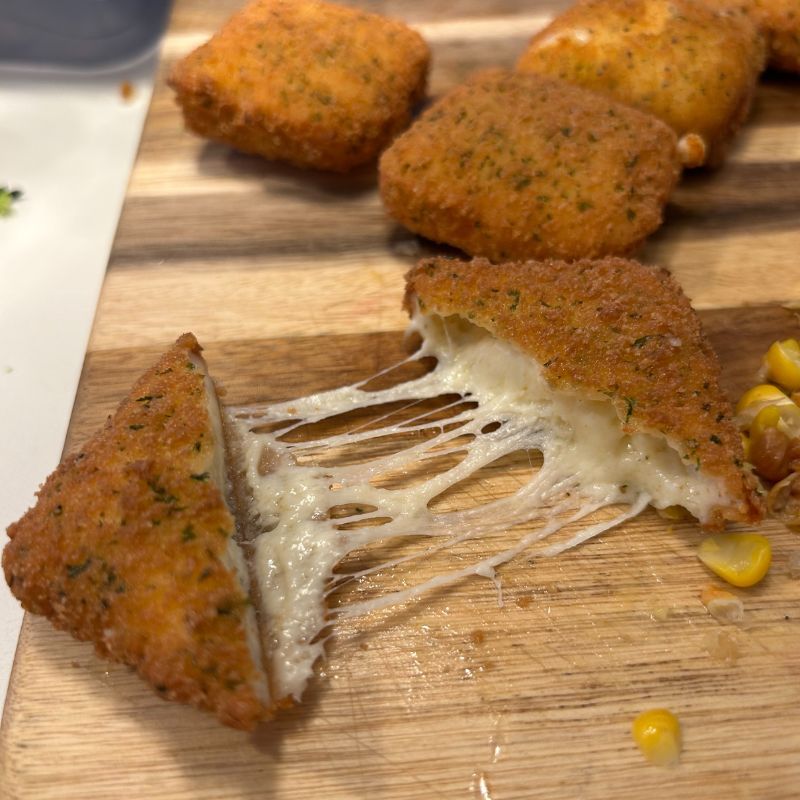
I found some pre-made frozen mozzarella dippers that had deep fry instructions on their packaging, so I thought this would be a great thing to test. The instructions said to cook at 180°C for 4-5 minutes. We got them out just after 4 minutes, and they were cooked to perfection. The cheese was perfectly melted, and the pull when we cut them in half was *chef's kiss*. So easy and so tasty!
Cooking corn on the cobs

This one was a bit rogue, and we didn't know what to expect, but we decided to chuck a quarter of a corn on the cob into the deep fryer at 180°C, for 4 minutes. It came out cooked and almost crispy around the edges. My husband shucked the corn from the cob and tossed it in salt. It was delicious!
Cooking halloumi
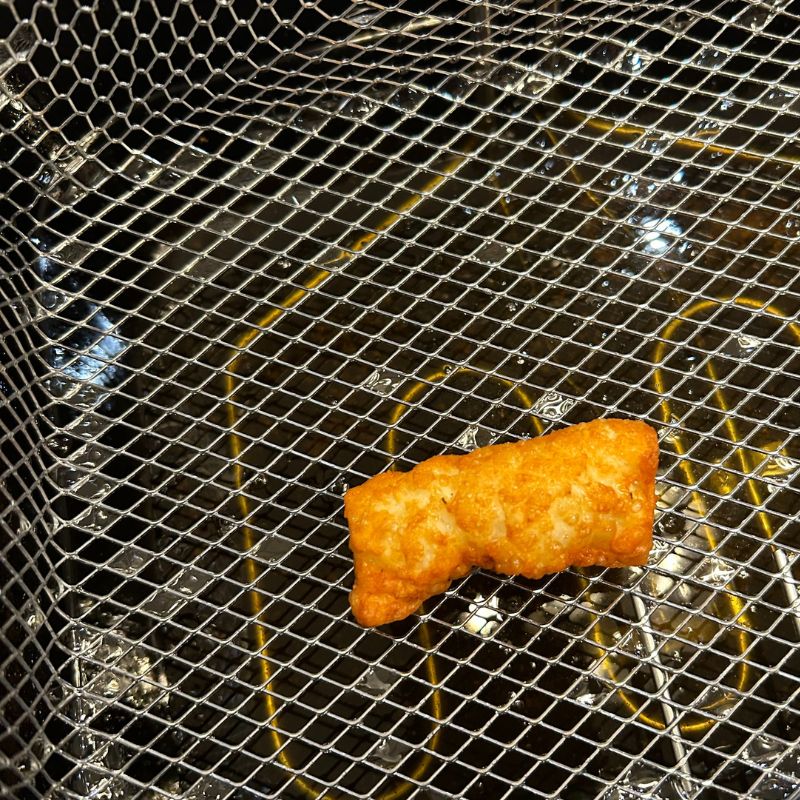
Deep frying halloumi is arguably the easiest way to cook this cheese, and it offers seriously tasty results. We didn't coat it; we simply threw it in as it was, and truly, it tasted 10 times better than it does when pan-fried. After 3 minutes at 190°C, it was perfectly browned and crispy on the outside, yet perfectly soft on the inside. It did shrink a little, but that was expected.
You can fit so many slices of halloumi into one basket. Easily a block or two, if need be. I would definitely do this again, especially if I were hosting for several people.
Cooking potato rosti
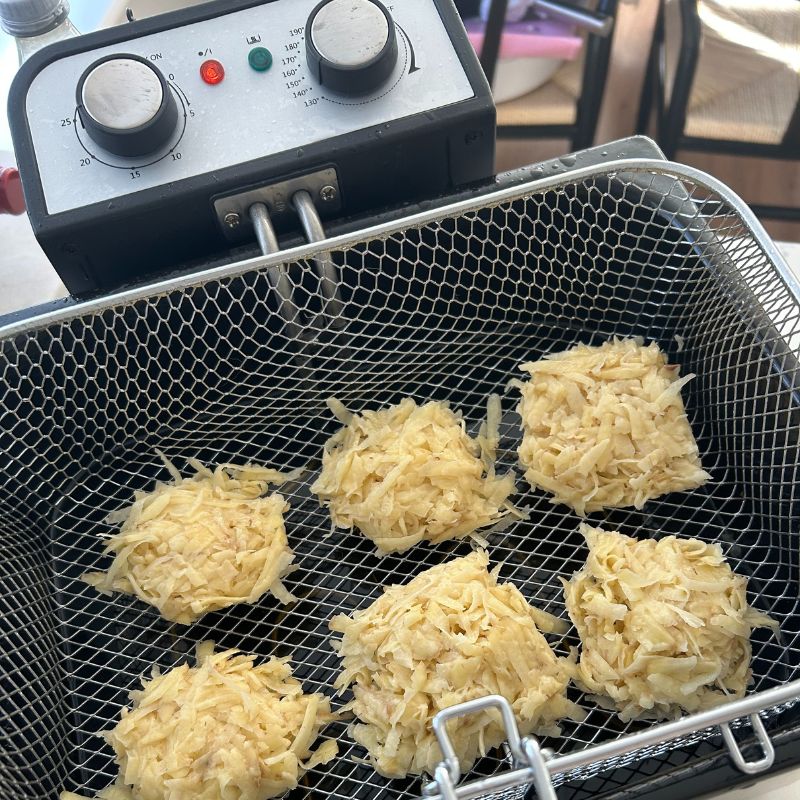
It turns out that grated potatoes and an egg, moulded into patties and thrown into the deep fryer, turns into an incredible breakfast — with an egg on top of course. We cooked these the same as the chips, so we initially put them on low at 130°C for 10 minutes. Took them out, let the oil drain and let them cool down a little, then dunked them back in for 5 minutes, at the highest temperature.

Admittedly, they were a little too crispy. So, next time we will cook them for the second time at 180°C, for maybe 4 minutes. Also, you don't want to make them too thick, or the inside won't be fully cooked, but the outside will be crunchy.

Cooking onion rings

We made a batter using self-raising flour and sparkling water and dipped our rings of onion in it generously. We set the deep fat fryer to 190°C and cooked them in batches, ensuring not to overfill the basket, for approximately 5 minutes or until they were very brown. These were delicious and incredibly easy to make.
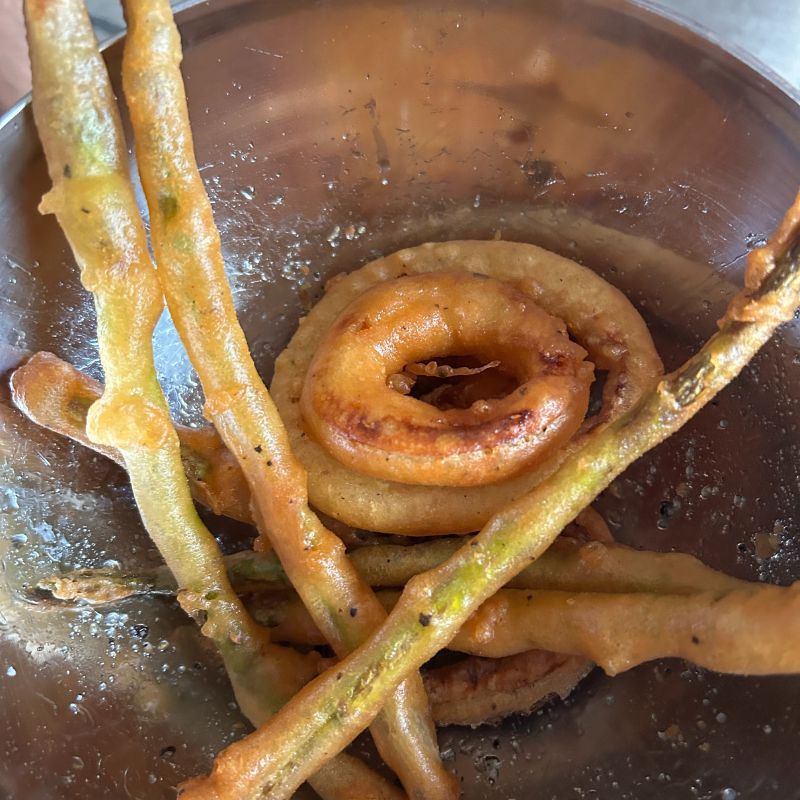
We also dipped some asparagus stalks in the same batter and cooked them along with the last of the onion rings. These took roughly the same amount of time and tasted great, too. They were perfectly cooked both inside and out.
Cooking breaded mushrooms
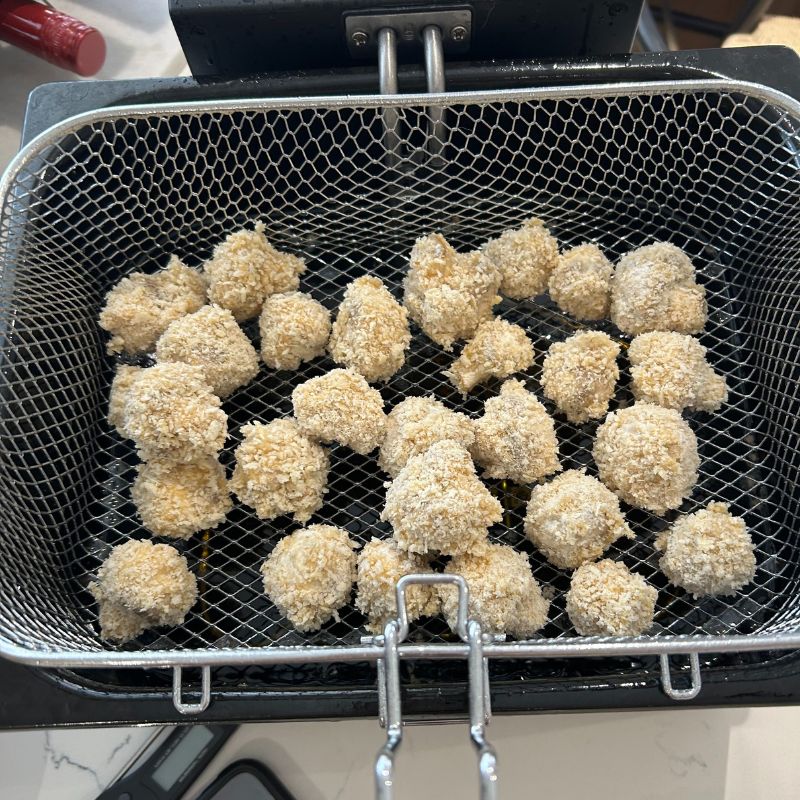
Cooking breaded mushrooms
To make our breaded mushrooms, we used a mixture of panko breadcrumbs, flour and egg. We dipped each button mushroom in each, ensuring they were well coated. We put them in the fryer again at 190°C, for around 6 minutes. Again, these were so effortlessly tasty and they crisped up so well.
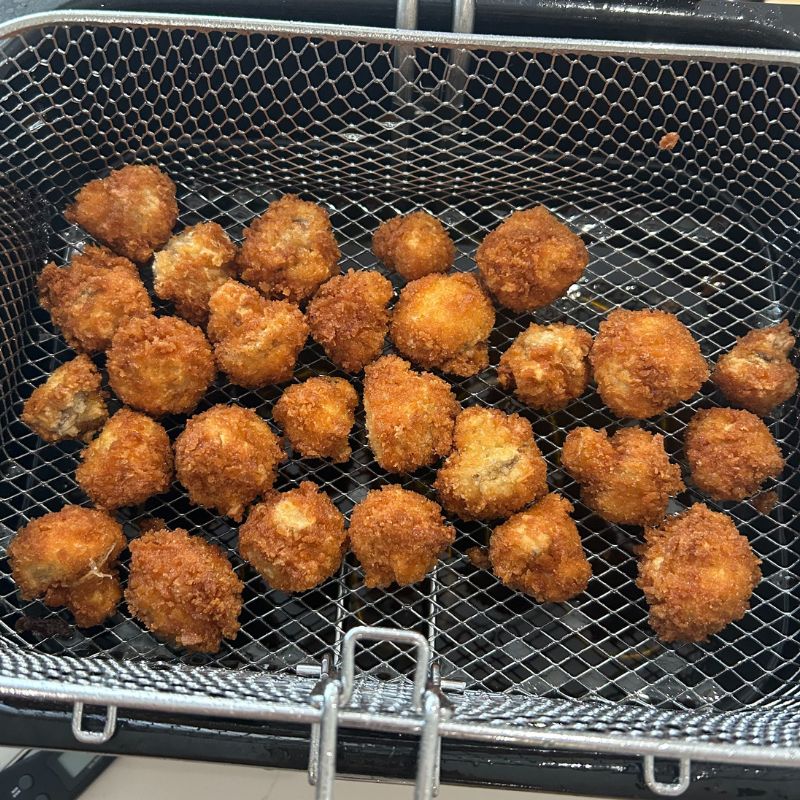
To turn this deep fat fryer off, you need to adjust the temperature to the lowest it can go. The green light will turn off and stay off. If the timer is set, this cannot be adjusted; however, you'll want to switch it off at the mains and unplug it. Then, the red timer light should go off.
After switching this deep fat fryer off at 190°C, it will take quite a few hours for it to cool down and reach a safe temperature. Even once I turned this one off at 8PM, it was still reaching 70°C at 10PM.
Cleaning
The nature of deep fat fryers means that they are not an easy appliance to keep clean. But the fact that you can detach the heating element and control panel from the main unit on this one means it's a lot more convenient than other models.
After each use, I soaked the basket(s) I had used in warm, soapy water and dried them well. Otherwise, I mostly had to clean the exterior of the deep fat fryer, as it had oil splatters over it.
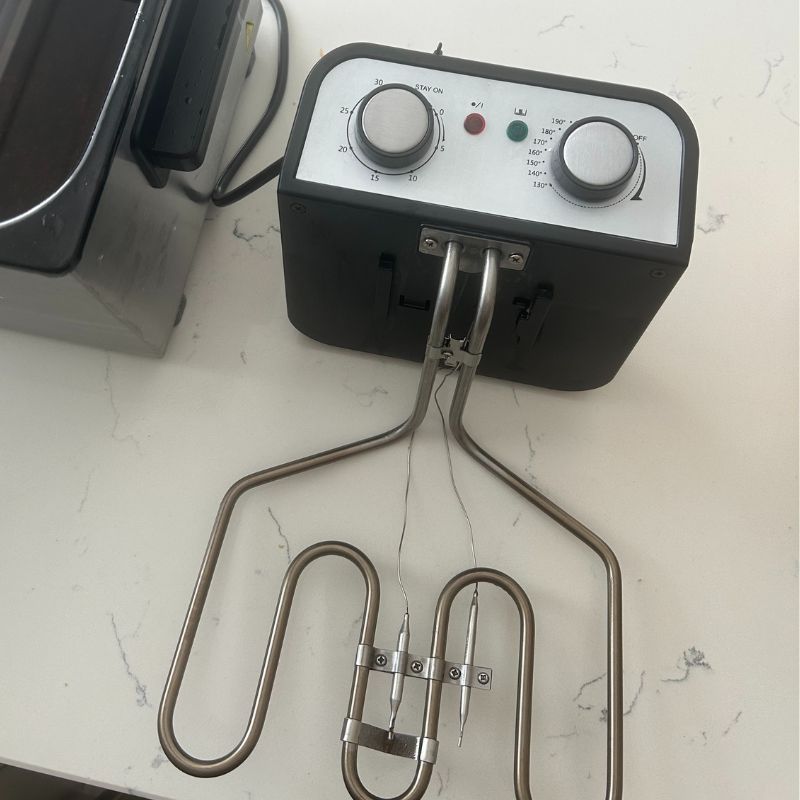
It says in the manual that the fryer needs to be fully cleaned after every use. The bottle of vegetable oil that I used says to change the oil every 2-3 uses. Because I used this fryer 4 times in 3 days, I left the oil in the main unit but covered it with its lid. I removed the baskets from sitting in oil between cooking sessions.
After my last batch of cooking, I waited for the deep fat fryer to completely cool, and then poured the oil into a plastic bottle for disposal. I removed the control panel and heating element, which is connected to the plug, from the main unit. I wiped the heating element and panel with a damp cloth and then cleaned the cooking chamber in my sink, in water with lots of soap.
How does it compare to similar models and its predecessors?
Currently, this is the only deep fat fryer that Salter sells. They do sell a huge range of air fryers, however.
In comparison with our top-rated deep fat fryer, the Lakeland 3 Litre Electric Deep Fat Fryer, there's minimal price difference. The Lakeland model is £59.99, while the Salter is £57.99.
There is, however, a huge size difference — the Lakeland offers 3L while the Salter is 5L, so this is more suitable for families. Both have the same temperature options, 130°C to 190°C. They work in similar ways, with one dial for temperature and the other for time, and design-wise, they are alike, too, with each offering a viewing window. The real difference between them is size. If there's only one or two of you, go for the Lakeland one as it's small and easier to store. If you're cooking for more or often host, then go for the Salter one — but be prepared that it needs a bit more storage space.
Should you buy the Salter Deep Fat Fryer?
This Salter fryer takes the hard work out of deep fat frying foods thanks to its easy-to-use control panel, and the fact that it comes with different size baskets so that you can cook different foods together, while keeping them separate. Its 5L size is great for families, while this does make it admittedly harder to store. If you are only two people and don't often host or use your deep fat fryer for anything more than chips, this one might be too large. Cleaning it was super easy, thanks to the fact that the cooking chamber separates from the heating element, display panel and plug socket.
All in all, for less than £60, this is a bargain with other deep fat fryers on the market coming in at a similar price, but at a much smaller size. The only thing to note is that its cord is short, so do think about where it can safely be used in your kitchen, that's also near a power outlet.
!["[T]he First and Fifth Amendments Require ICE to Provide Information About the Whereabouts of a Detained Person"](https://images.inkl.com/s3/publisher/cover/212/reason-cover.png?w=600)






